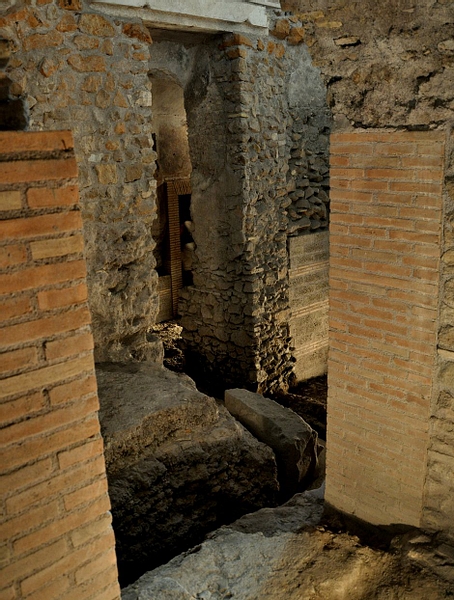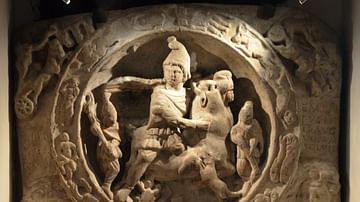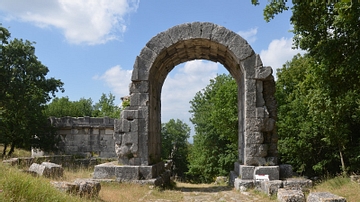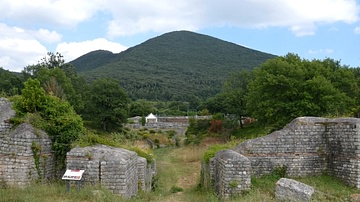Underground archaeology is a niche topic and is highly specialized. We're talking about simple structures underground, such as those of Roman North Africa (able to withstand the heat), or we can get as extreme, in a mostly urban context, as where the underground archaeological palimpsests are complex and highly suggestive.
Pointing the finger at any European capital, we immediately think of the catacombs and tombs, but in the archaeological world of the underground, there is much more than mere funerary works.
The extreme example that shows what I mean is Rome, the capital has on average 10-12 meters in urban stratification corresponding to 2500 years of history. This layering extends over almost the entire city within the Aurelian Wall and touches, at the excavations carried out during the construction of subways, even greater depths.
By stimulating the memory, we think of the best-known underground sites such as the Balbi Crypt, the Domus Aurea, the basement of the Coliseum, not to forget the tomb of the Scipios, we get about a dozen sites that are normally remembered - everything else is virtually unknown.
Why unknown? The first problem, which creates a domino effect, is that the management entity of these sites is not unique, rather it depends on the location of the site and whether it is managed by the municipality, the Ministry of Cultural Heritage or the Vatican, which in turn depends on what now stands on top of these sites.
Buildings of public administration? Municipal buildings? Vatican churches? From this starting point, we can understand why there isn't a Corpus, or a full scientific literature, dealing entirely with underground Rome, there are books (not academic) that only talk about a few major sites, or classify the cavities according to the better-known cavities. Little academic feedback, little knowledge, little interest.
The main problem is clear, the lack of specific literature and unambiguous terms that allow a database search of the sites excavated. This is because for these sites, excavation and interpretation aren't different from subaerial sites, but being underground creates the unique features that are totally different from those in the open. The subaerial ones, for example, are, especially in Italy, at the constant mercy of the weather, collapses, and vandals, but not only, in subaerial excavations, we often see a single time window that may be contaminated by later structures or earlier ones (depending on the cases). The main feature of the underground excavations instead (especially those of Rome) is that the time window is open. The archaeological palimpsests show us the various phases of urban stratification, so do not classify these sites depending on the primary intended use (it would be impossible for each site that contain several buildings and structures), but categorized by their particular mode of preservation that also determines access. Narrowing the concept: do not compare the past, but the present.
If there were a few sites, creating a section for Underground Rome would be useless, but given that between the inside walls and outside walls there are about one hundred underground sites, we understand the need to learn more.
But how can we proceed, starting from scratch, given the lack of specific literature and access to a dedicated bibliography? We are forced to find a needle in a haystack when you consider the archaeological city that is Rome. As a last lifeline then, to get the initial bibliographic data, scientific journals were taken into consideration, hoping that at least one had published at least thirty articles, on Underground Rome, just to know where to begin.
The archaeological journal Forma Urbis, edited in Rome, and that is mostly about Rome, is written entirely by academics and teachers of Italian and foreign universities. Of the archive of a period of 15 years (about 160 months' worth of material) almost a hundred articles about the various sites of Underground Rome have been published. Considering the incredible amount of scientific material from this magazine, as an initial basis for this project it was decided to consider for the moment, only the sites within the Aurelian Walls, 64 academic articles, corresponding to as many sites, that do not speak, as in some books, about one of the best known archaeological significance, but take into consideration the entire archaeological palimpsest visible.
Having defined the initial number, the next step was to find the scientific literature for each site (made possible after having found all of the names of the sites in the journals), to associate administrative body, the accessibility, openings and a degree of interest defined by the cultural and tourist associations (not academic).
Along with this bibliography search, inspections have been made in person, to see the general state of sites open to the public and to see how the archaeological relevances are also shown to disinterested tourists. Together with the field work and taking into consideration the partial works, it turns out that talk of underground sites, not only of Rome, may be more complex than you might think, this is because terms and activities are subject not to archaeological practice, but to Speleology study, which has fallen, until now, under the field of Geology, not under Archaeology.
Let's see why.
In geology, when we study fossils, the first thing we do in front of two findings is to look for similarities between the two, using analogies in order to understand their evolutionary stage, we identify the species and any mutations that occurred through the ages. The same thing we do with the latest findings, from ceramics to the same sites, comparing the composition of the planning or strategy.
Everything we do in archaeology is to identify what in geology is called guide fossils due to the distribution and quantity of guide fossil found in the world, we get the dating of the various geological stratigraphy, but it also allows us to frame temporally other fossils in the first hitherto unknown date. This is particularly the case where, in a stratigraphic level, the unknown fossil is displayed together with the guide fossils.
Finding, identifying, dating. Archaeology and Geology apply the same method of working in relatively different temporal contexts, but what we absolutely know is how and when these two disciplines meet. There are situations midway between these two sciences, the fundamental subjects in common and useful for both, such as stratigraphy, pedology, recognition rocks, the composition of local outcrops and speleology. We can say that seeing the examples above, the geology is most often in the service of archaeology. Indeed, it would be more correct to say that geology is an integral part of modern methods of archaeological excavation, and it is unclear how such fields as pedology and stratigraphy are useful to archaeological excavation, but Speleology?
Speleology is the scientific method, proper and safe of exploration of underground cavities in geology and is practiced in order to understand the genesis and nature of natural cavities, whose single term is generally HYPOGEUM. We are still in Geology and specify that among the possible natural hypogea we have the karst, caves created by volcanic activity, natural underwater caves and so on.
In archaeology we like to use the same method of exploration of underground cavities used by geologists, but the exploration is not limited to natural cavities, of course. From here the distortion for the past years, the archaeological underground cavity is termed as the geological, simply Hypogeum, in each case we tried to classify the alleged underground archaeological according to intended use, mithraea, nymphs, warehouses, places of worship, public works and so on.
It's clear that there is no equivalent in archaeology of geological HYPOGEUM, but there are cavities that have long been laid underground. But following the natural order of what geology teaches us we can say by extension that the Hypogeum is what is born and remains underground. The same definition can be applied to the archaeological artificial cavities, where Hypogeum, is the archaeological site that was underground at the time of construction, and remained underground until the present day (as opposed to if not more would be an ex-buried underground) so there aren't only the catacombs but also the columbarium, the tombs, the mithraea, some nymphs, the tunnels, aqueducts, sewers, and all areas of service as a tank, some caves, cellars. Everything else is in the category of simple Underground Archaeological Structures.
From here a long discussion on the reuse of existing buildings, to understand the relationships between the various layers, see for example, the church of San Clemente, in the deeper levels was created an underground room (Hypogeum visitable) used as Ninfeo, in the summer zone of a Roman functionary house, then the buried room has been converted to mithraeum, that with the subsequent construction of the San Clemente titulus adjoining the house, was finally closed. The titulus built next to the house, used as base, the second floor of a warehouse (Moneta) that existed next to the house (now visitable). But the matter does not end here, the titulus also had a catacomb (the Hypogeum can't be visited) created at an intermediate height, and that today cuts into part of the warehouse, and part of the house, but we know that the catacombs are underground, then in the stratigraphy we see two Hypogea in two different time phases and the remains of the house, the warehouse and titulus as underground structures today.
But our spirits can be raised by the fact that the sites aren't all so complicated, San Clemente is in itself the most complex, the Colosseum to the contrary is the simplest because it sits on a zero level after the fire of Nero then its corridors, and collectors and two floors below the cavea will not cut anything and are the simplest example of archaeological hypogea.
Having now, the number of sites and terms of use, the last thing to do was to standardize the name of each site in order to facilitate the bibliographic research, to do this for each site was found in the voice of Lexicon Topographicum Urbis Romae (Steinby) and which refers to the entire bibliography.
With all this data was created a map that shows precisely these underground sites of Rome published by the Forma Urbis magazine. Each point marked on the map is named with the original Latin name given Lexicon and we also provide the additional information, such as the Regio and the administrative unit.
But why should archaeologists have all the fun? Most of the underground sites, few know it, are open to the public, and this will be indicated on the website, if the site is open, if it is available to special openings and a degree of interest (only for tourists).
This work, as we have said, is not complete but is a base to work on, using the magazine was a ploy to have a starting point. The project is constantly monitored and updated each time a new site is identified, not yet marked on the map, we take care finding a complete bibliography, although the site is not mentioned by the Lexicon.
Rome has dispensed canonical rules to the whole empire for centuries, but in Rome, none of these rules were ever applied, the movement and restlessness of the city are clearly visible between the Roman Forum and Palatine Hill, but where this urban movement is really clear, is underground. There is nothing more beautiful than walking through the centuries using only a ladder.







